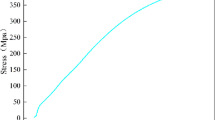Aluminum casting alloys exhibit creep behavior when the materials are exposed to high temperature and load. In this article, the stress- and temperature-dependent creep behavior of a die casting A380-T5 aluminum alloy was simulated using a classical constitutive model. The bolt-load retention behavior of the material was analyzed in a head bolt joint in an aluminum engine under thermal cycle condition using the finite element method. In this simulation, transient thermal analysis was performed first to calculate the metal temperature at the head bolt joint as a function of time during engine thermal cycling. This temperature was then input as the thermal loading in the subsequent structural analysis to calculate its effect on the bolt-load retention. The finite element analysis (FEA) model for the bolt-load retention simulation includes not only the plasticity in all metal components but also the creep properties of head bolt threads in the cast aluminum engine block. The FEA model was validated by good correlation between the predicted head bolt-load loss and the experimental measurement during engine thermal cycling. The simulation results also indicated that creep in the head bolt threads of cast aluminum engine block was mainly responsible for the load loss in the head bolt joint.








Similar content being viewed by others

References
J. Webster: SAE 941738, SAE, Warrendale, PA, 1994
V. Dattoma, G. Demelio, W.M. Sun, A. Torneo, and N. Tristano: SAE97A053, SAE, Warrendale, PA, 1997
I.J. Polmear, G. Pons, Y. Barbaux: Mater. Sci. Technol., 1999, vol. 15 (8), pp. 861–68
Z.L. Gong, T.R. Hsu: J. Test. Eval., 1991, vol. 19, pp. 14–23
J.G. Kaufman: Properties of Aluminum Alloys: Tensile, Creep, and Fatigue Data at High and Low Temperature, ASM INTERNATIONAL, Materials Park, OH, Aluminum Association, Washington, DC, 1999
A. Luo, B. Powell: Tensile and Compressive Creep of Magnesium-Aluminum-Calcium Based Alloys, TMS, Warrendale, PA, 2001
R.E. Reed-Hill: Physical Metallurgy Principles, 2nd ed., PWS Publishers, Boston, MA, 1973, pp. 827–87
Q.G. Wang: unpublished research, General Motors Corporation, 2002
Acknowledgments
The authors thank William Wistehuff and Scott Kociba for providing useful design and testing information. The authors also thank Dr. Jayaraman Sivakumar and Dr. Dale Gerard for their valuable comments to the manuscript.
Author information
Authors and Affiliations
Corresponding author
Additional information
This article is based on a presentation given in the symposium entitled “Simulation of Aluminum Shape Casting Processing: From Design to Mechanical Properties” which occurred March 12–16, 2006 during the TMS Annual Meeting in San Antonio, Texas under the auspices of the Computational Materials Science and Engineering Committee, the Process Modeling, Analysis and Control Committee, the Solidification Committee, the Mechanical Behavior of Materials Committee, and the Light Metal Division/Aluminum Committee.
Rights and permissions
About this article
Cite this article
Chang, CC., Wang, Q. Modeling of Bolt Joint Behavior of Cast Aluminum Alloy (A380-T5) by Coupling Creep and Plasticity in Finite Element Analysis. Metall Mater Trans B 38, 607–613 (2007). https://doi.org/10.1007/s11663-007-9056-z
Published:
Issue Date:
DOI: https://doi.org/10.1007/s11663-007-9056-z



